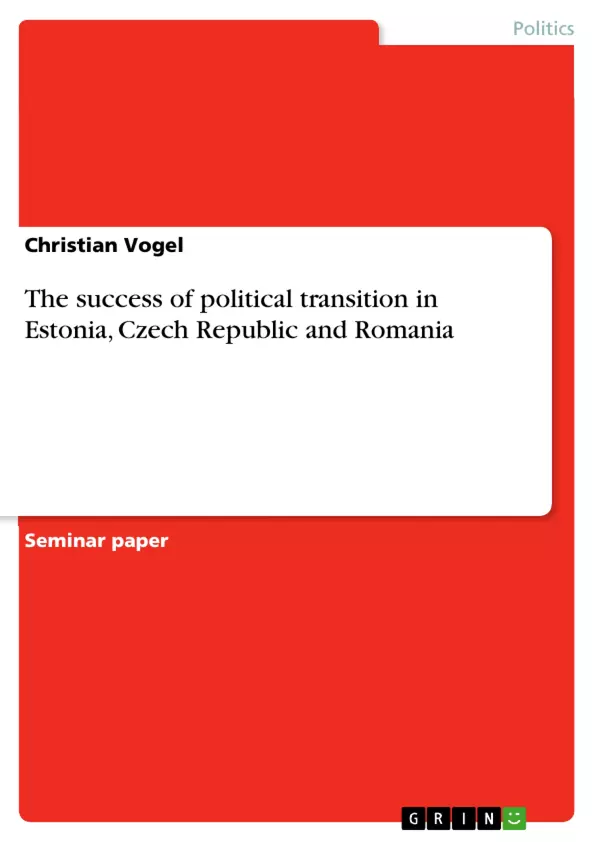1. Introduction
After having discussed major theoretical approaches regarding political transition as far as post-communist countries are concerned in the first stage, it is due to fill this theoretical framework with examples and figures. Being aware of some common steps every country, which finds itself in a transitional process, has to undertake in order to establish a functioning democracy, the theory also shows that the course as well as the success towards the before said goal might be completely different.
Against this background, the main aim of the current research is a comparison of three former communist states, namely Estonia, Czech Republic and Romania, regarding their progress of the transitional process up to the present moment, thereby mainly focusing on political aspects. In doing so, one has to realise that the evaluation of political transition is much more complicated than assessing economical transition for example, because neither success nor failure of can be just displayed in figures as it might be possible for economical issues. However, theory has been proofing that one can not assess developments of countries in transition while only focusing on economical outcomes. Even the neo liberal hardliner and American scientist and philosopher Francis Fukuyama has been admitting in his recent publication “States-Building”, that creating states under the rule of law is even more important than free markets . In respect to that, this work tries to use the few measures existing in order provide an objective comparative analysis. In addition to that it should be evaluated in what way the opportunity to join international organisations (NATO and especially the European Union) has been boosting political transition in the above mentioned countries. Moreover it should be found out whether there is a connection between successful transition and deeper European integration.
For that matter, the first part compares general developments of political transition. The second part is analysing developments of the three countries regarding their way towards NATO and EU accession, which has in fact both become reality for Estonia and ČR. The last part tries to provide a conclusion about the outcomes of the (political) transition process as well as to point out remaining problems which are still due to resolve.
Inhaltsverzeichnis (Table of Contents)
- Introduction
- Development of political transition issues
- First steps and distinct issues during the initial phase
- Crucial issues and strategies of political transition
- Country ratings by comparison
- The citizens' attitudes comparison
- Freedom House country classification
- Democratic contestability assessment
- Developments towards international organisations
- NATO membership
- EU enlargement
- Conclusion
Zielsetzung und Themenschwerpunkte (Objectives and Key Themes)
The main objective of this research is to compare the political transition processes of Estonia, Czech Republic, and Romania since their respective transitions from communist rule. The research focuses primarily on political aspects, acknowledging the complexity of evaluating political transition compared to economic transition. The paper aims to provide an objective analysis using available measures and explore the impact of joining international organizations, particularly NATO and the European Union, on the political transition in these countries.
- Comparative analysis of political transition in Estonia, Czech Republic, and Romania
- Impact of distinct initial phases on the transition process
- Role of international organizations, particularly NATO and EU, in promoting political transition
- Relationship between successful transition and European integration
- Evaluation of the political transition process and remaining challenges
Zusammenfassung der Kapitel (Chapter Summaries)
The introduction presents the theoretical framework for analyzing political transition in post-communist countries, highlighting the diversity of experiences despite shared challenges. The research focuses on comparing the political transition in Estonia, Czech Republic, and Romania, emphasizing the importance of considering political factors alongside economic ones. The paper aims to provide a comprehensive analysis of each country's transition journey and explore the impact of international organizations, particularly NATO and EU accession, on their political development.
Chapter 2 delves into the development of political transition issues, focusing on the initial phase. It highlights the different starting points and challenges faced by each country, including Estonia's focus on nation-state building and marketization, Czech Republic's pre-existing national state structure and focus on establishing a stable democracy and market economy, and Romania's unique history marked by a totalitarian regime and violent revolution. The chapter analyzes the significance of various issues and their impact on the initial steps of transition.
Schlüsselwörter (Keywords)
This research focuses on the analysis of political transition, comparative analysis, post-communist countries, Estonia, Czech Republic, Romania, NATO, EU enlargement, nation-state building, marketization, democratic consolidation, economic transition, and the impact of international organizations on political development.
- Citar trabajo
- Magister Christian Vogel (Autor), 2005, The success of political transition in Estonia, Czech Republic and Romania, Múnich, GRIN Verlag, https://www.grin.com/document/75140



